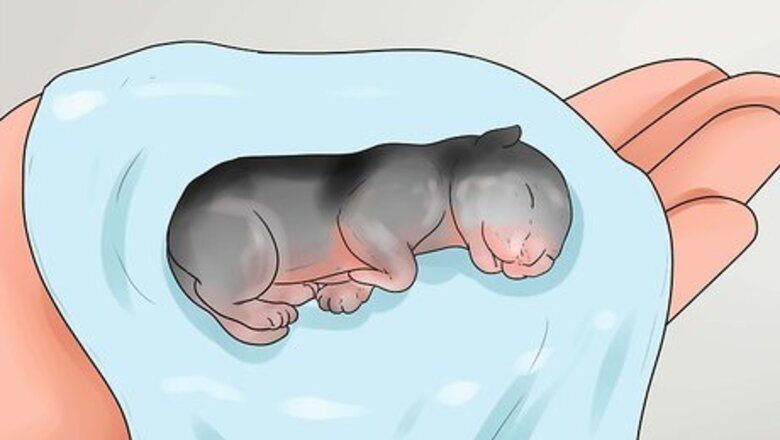
views
Making Your Kittens Comfortable
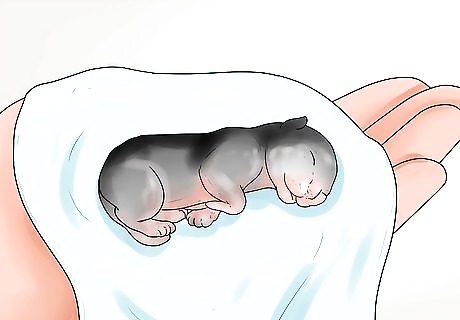
Dry the kittens with a warm, dry towel. A good mother-cat will lick the newborn to remove the birth membranes – this helps dry the kitten and stimulate her to breathe, which is important for premature kittens. If the mother is not able to perform this task, gently dry each kitten in turn in a soft, warm, dry towel. Rub her with small circular movements so as to mimic licking, and continue until her coat is dry. Keep all the kittens together because their mutual body heat will help protect against chilling. A premature kitten has a large surface area to volume ratio and is therefore prone to rapid cooling. This is disastrous because a kitten cannot control her own body temperature and a cold kitten with quickly stop feeding, become moribund and die.
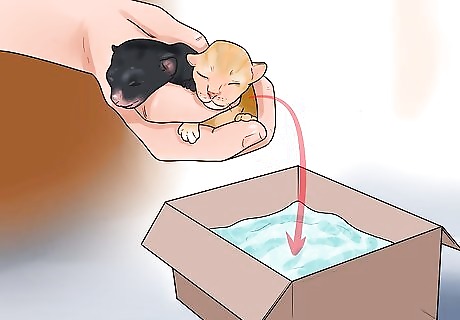
Place the kittens into a makeshift nest that is warm and dry. Your premature kittens are going to want to snuggle up to each other to keep warm. Get a box that is big enough for all of them and line it with towels and a heating pad or hot pack. Make sure the heating pad doesn't come into direct contact with the kittens or else their delicate skin may get burnt. Place it under a layer of towels so the kittens can still feel the warmth, but don't risk hurting themselves.
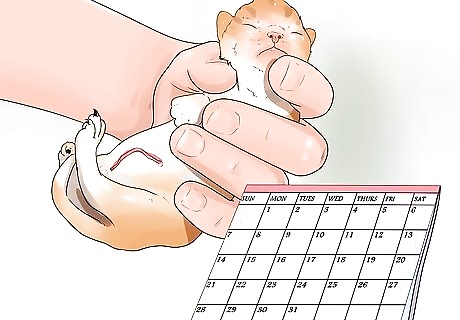
Leave the kittens’ umbilical cords intact. There is no need to cut the umbilical cord on a kitten or to remove the remnants of placenta dangling from each kitten's umbilicus. Leave the umbilical cord and the placenta. They will dry out, shrivel up, and fall off within the first 7-10 days of life. Cutting the placenta can lead to hemorrhage, hernias, or even introduce infection into the navel, which could prove fatal to the kitten.
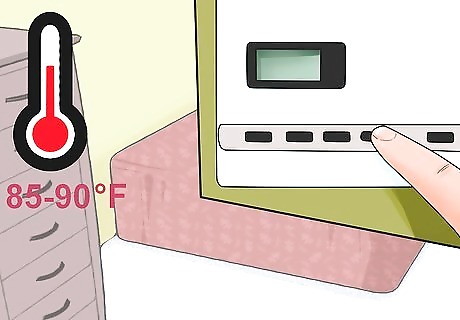
Keep the room temperature between 85-90°F (29-32°C). A premature kitten cannot move away from, or towards, heat. Therefore it is of vital importance that you provide the correct temperature. For the first three weeks of life the newborn should have a body temperature of 96-100°F (35-37°C). To achieve this temperature, keep the ambient room temperature between 85-90°F (29-32°C). Lower the temperature to 80°F (27°C) in the second to third week of life. By this time the kittens will have more control over their body temperature. Rather than heating your entire house to this temperature, heat 1 room of your house and designate it as the kittens' room. Provide additional warmth in the nest, too. This can take the form of a heating pad or a hot water bottle wrapped in a towel. Fill the hot water bottle with boiling water but make sure the kitten cannot have direct contact with the hot water bottle since she may be burnt by it. It is possible to overheat a kitten. If this happens, her ears will appear flushed red and she will feel hotter than normal to the touch. Hot kittens appear distressed and may vocalize it. If she is able to move, she will not stay still because she will want to move to a cooler spot.
Feeding Your Kittens
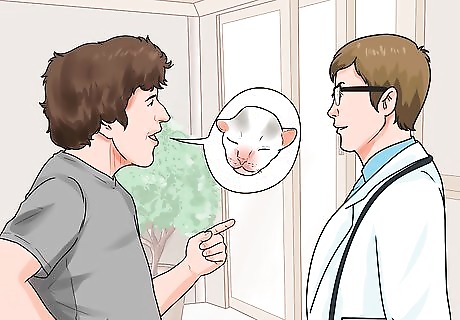
Consider seeking help from your veterinarian or local animal shelter. Bottle feeding kittens on your own is a demanding task. You will need to feed the kittens every 1-2 hours around the clock for the first week of their life. This is necessary to give the kittens the best chance of survival. Don’t be afraid to ask for help from your veterinarian or local animal shelter. They may be able to provide a surrogate mother cat or connect you with volunteers who have experience with bottle feeding newborn kittens. Some organizations may even be able to provide you with free supplies to help you care for the kittens.
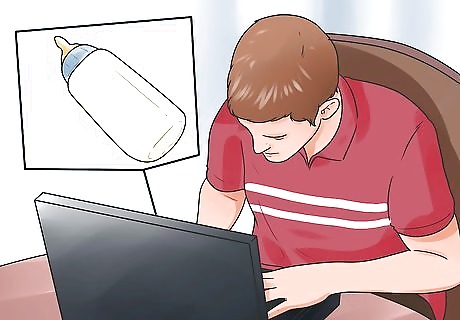
Get kitten-safe milk if the mother-cat is unavailable. A young kitten can only digest milk from the mother-cat. If the mother cat has abandoned her kittens, you will need to feed the kittens a cat-milk replacement. Cow's milk is not suitable because it contains lactose which many cats cannot digest and it will give them diarrhea. In an emergency situation, goat's milk is unlikely to cause harm and will stop a newborn from getting dehydrated. Cat-milk replacement formula is available via the internet or from your local veterinarian. These formulas are an exact replica of the balance of fats, proteins and vitamins found in a queen's milk. They come in powdered form and are reconstituted with boiled water, in much the same way that human milk replacers are. Always make each feed up fresh prior to use, since the high fat content encourages bacterial growth and quickly becomes contaminated.
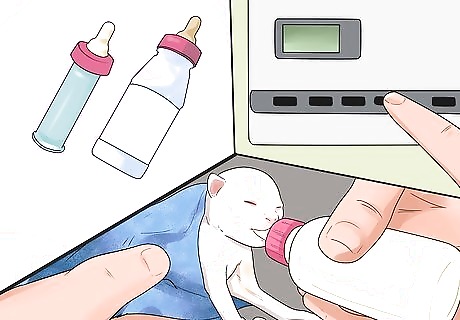
Prep your kittens' environment and food. Make sure the kitten is warm – a chilled kitten will not be able to digest milk which will then curdle in her stomach and make her ill. Make up sufficient milk replacement for that feed and place it in a clean, sterilized feeding bottle. Special feeders for premature kittens are available, which have the advantage of being a convenient small size so they are easy to use with tiny kittens and don't waste milk. A premature kitten has a lot in common with a cold-blooded animal – if the room is chilly she cannot generate a high enough temperature for the enzymes of digestion to work.
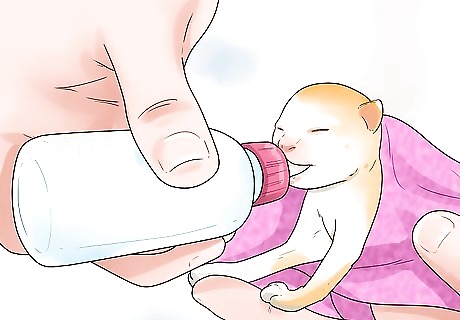
Position the kitten on her belly if you're feeding her yourself. Place the kitten on her belly, in a similar way that she would suckle from the mother. It can help the kitten to find the teat if you first put a drop of milk on the tip and touch it to her lips. If the kitten still will not suckle, try stroking its head and back to encourage it to feed. When the kitten starts to make a sucking noise, try to offer the nipple again. Allow her to suckle until her belly is nicely rounded, but not bloated and tight. You can check this by feeling to see if her tummy is wider than her ribcage – if it is then her stomach is full and she has had sufficient feed for now. Many kittens will fall asleep on the teat when their tummy is full. If this happens, gently remove the teat from her mouth and place her back in the warm nest.
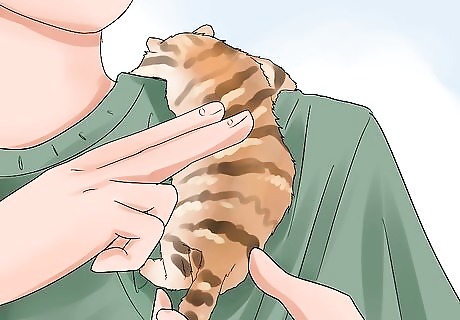
Burp the kittens after a formula feeding. Kittens need to be burped after a formula feeding, so you will have to do this yourself. To burp a kitten, place it over your shoulder on its stomach and gently pat it on the back. Keep patting until you feel or hear a burp. Make sure that you use a damp towel to clean off any formula that the kitten burps up.
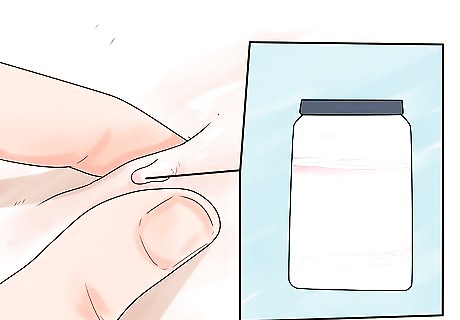
Make sure the kittens get their mother’s colostrum, if possible. Shortly after giving birth, the mother-cat produces special milk called colostrum, which is high in antibodies. These are immune complexes that help to protect the kitten against diseases that the mother has encountered, similar to a vaccination. The colostrum strengthens the kittens and may even improve their chances of survival. Colostrum is also rich in the vitamins and minerals that kittens need for normal growth and development.
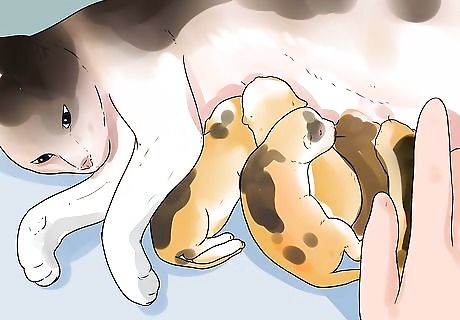
Help each kitten get her mother's milk, if necessary. A strong kitten will latch onto the nipple when placed against it, and start to suck. A weak kitten may need some help. To do this try expressing a drop of milk/colostrum from the nipple, and touch her mouth to the milk so as to get a taste and encourage her to latch on. The rear teats tend to produce the most milk. When expressing colostrum, chose a rear teat and gently place the fore-finger and thumb of your dominant hand just behind the nipple. With a gentle squeezing-pulling action travel the finger and thumb to towards the teat. Do this repeatedly and oftentimes the dam will release milk. Make sure they feed often. A premature kitten is entirely dependent on her mother's milk for nutrition. She feeds little and often, with a newborn feeding as frequently as every 1-2 hours.
Ensuring Your Kittens' Health
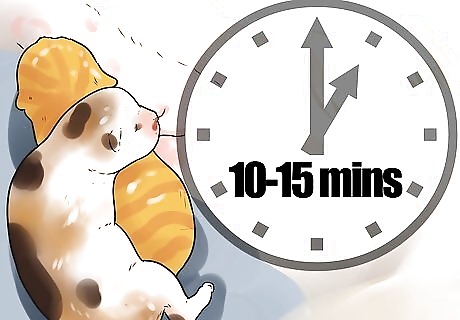
Stick to a healthy feeding schedule. Premature kittens have tiny stomachs which can only hold a small volume of milk at any 1 time, so they need to eat often to get the nutrition that they need. This means that each kitten will suckle for 5 to 10 minutes every 1 to 2 hours – night and day! To be successful hand raising kittens there are no short cuts and each one must be fed every 1 to 2 hours for the first week of its life. Here is a sample feeding schedule: 1-3 days old — feed 2.5ml of milk replacer every 1-2 hours 4-7 days — feed 2.5–5 milliliters (0.08–0.2 fl oz) every 2 hours 6-10 days — feed 5 – 7.5ml, every 2-3 hours 11-14 days — feed 10-12.5 ml every 3 hours 15-21 days — feed 10 ml every 3 hours 21 days to 6 weeks — feed 12.5–25 milliliters (0.4–0.8 fl oz), every 6-8 hours in addition to a normal diet You will know if a kitten is still hungry because she will cry, and hunt around for the teat as if unsettled.
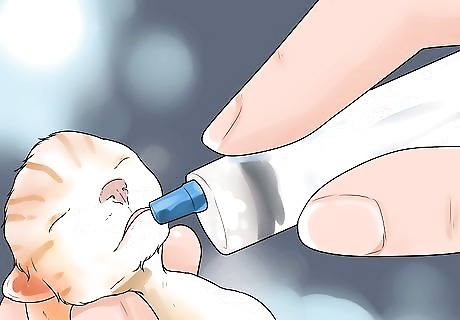
Use a syringe with kittens who won't feed. Some premature kittens have a weak suckling reflex and don't find it easy to suckle from a teat. If this, gently open her mouth by inserting a fingertip between her upper and lower lips. Using a syringe loaded with milk replacer, drip one drop of milk at a time onto her tongue. Allow it to trickle back and trigger her swallowing reflex. Time and patience is crucial since this process cannot be rushed. Never do more than a few drops in at a time, since larger volumes may run down into her windpipe before she has a chance to swallow. This could cause the kitten to drown.
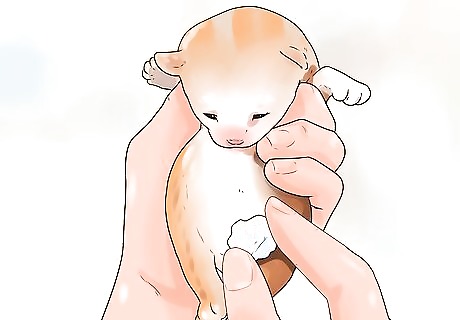
Stimulate the kitten to empty her bladder or bowels after each feeding. Young kittens cannot empty their bladder or bowels on their own until their second or third week of life. Instead they hold onto their toilet until the mother licks their anus and genital area which stimulates them to defecate and urinate. You will need to stimulate this reflex using moistened cotton balls after each feeding. Use the following process: After the kittens have been fed, use a cotton wool ball moistened with warm water to gently wipe the kitten's bottom. As you wipe the kitten’s bottom, the kitten should soil the cotton wool. After the kitten has urinated or defecated, discard the cotton ball in the trash. Use another moistened cotton ball if necessary. Dry off the kitten’s bottom with a clean dry towel before putting the kitten back into its nest. Repeat this process 3 or 4 times a day, washing your hands after each time. The kittens should defecate once per day and urinate each time you use this process. If they do not urinate every time, then they may not be getting enough water.

Keep the kittens’ environment clean. Kittens may become sick if they are exposed to germs and this can be a major threat to their survival Always wash your hands with soap and water before handling the kittens. You may also want to keep a clean shirt handy to put on over your everyday clothes prior to picking the kittens up so as to reduce the risk of contamination from the outside world. Take care to sterilize all bottles and teats between uses to decrease the risk of infection, too. To do this, use a sterilizing product designed for human baby bottles, like Milton solution. Or, if you have access to a steam sterilizer, this can also work well. Change the kittens’ bedding every day. Kittens may soil their bedding or throw up sometimes, so it is a good idea to change the kittens’ bedding every day.



















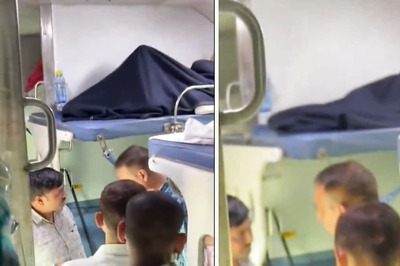
Comments
0 comment